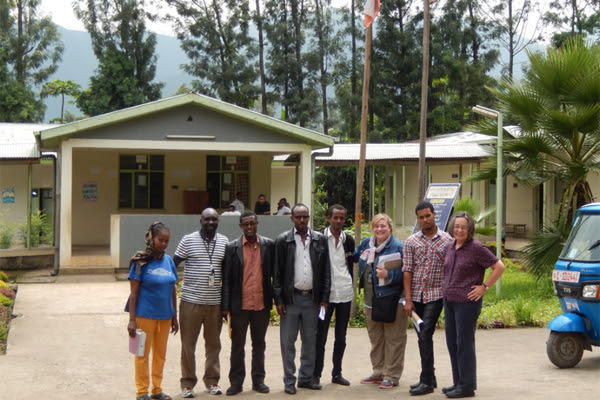
| Story | ||
| ||

Improving National Surveillance and Response Systems One Country at a Time
The 2014 Ebola outbreak in West Africa, the largest Ebola outbreak in history, taught us how easily a deadly disease can spread worldwide without effective surveillance and response systems to detect and control infectious diseases. CDC and World Health Organization/Regional Office for Africa
Integrated Disease Surveillance and Response
National public health systems are complex, and so are their surveillance and response activities. Integrated Disease Surveillance and Response (IDSR) is a framework for a nation to use to better manage and determine if the public health system is working well.
After Ebola, CDC and WHO/AFRO worked to make IDSR easier to understand and use, from the frontline health post to the top level of national public health. To evaluate public health system implementation, identify problems, and produce actionable recommendations, CDC and WHO/AFRO developed an IDSR assessment tool to address the five key points listed below:
After Ebola, CDC and WHO/AFRO worked to make IDSR easier to understand and use, from the frontline health post to the top level of national public health. To evaluate public health system implementation, identify problems, and produce actionable recommendations, CDC and WHO/AFRO developed an IDSR assessment tool to address the five key points listed below:
- List of priority diseases, conditions, and events,
- Standard or uniform case definitions for identifying priority diseases, conditions, and events,
- Critical denominators to analyze reported diseases, conditions, and events,
- Alert thresholds to trigger action for suspected outbreaks of epidemic-prone diseases, conditions, and events, and
- Quality of country’s epidemiologic or public health bulletin
“Public health surveillance has helped Ethiopia to detect outbreaks early, respond promptly and minimize the health, economic, social and political impact of public health emergencies.”- Zewdu Assefa Edea, MPH-EFETP Resident, Ethiopian Public Health Institute
Taking ownership in Ethiopia
While working with CDC, WHO, United States Agency for International Development (USAID), and the Western Michigan Evaluation Center, Ethiopia’s Public Health Institute (EPHI) took the lead to assess their IDSR capability and use. In May of 2016, a team of national and international disease detection experts used the tool to evaluate 13 sites across the country on the following activities: (1) documenting key elements of disease surveillance in Ethiopia, and (2) providing up-to-date, information and recommendations to make improvements.
Putting results to action
The assessment pinpointed specific areas that could improve Ethiopian surveillance and response system, which public health officials responded to quickly. EPHI has followed the recommendations to upgrade data collection and feedback systems, expand surveillance, and improve communications. EPHI is now offering health workers training in data management, public health emergency management, and rapid response. Revisions will serve as the baseline for further improvements in Ethiopia’s surveillance and response to health threats.
EPHI plans to expand the assessment to all regions in Ethiopia.
EPHI plans to expand the assessment to all regions in Ethiopia.
About This Story
CDC’s Division of Global Health Protection is working with 31 priority countries to develop global health security capabilities, which protect Americans and people around the world from disease threats. This story illustrates Ethiopia’s commitment to:
- Real-Time Surveillance: Launching and strengthening global networks of disease-surveillance systems that quickly detect outbreaks and assess risks.
Ethiopia’s effective, new IDSR evaluation pilot can help other countries improve their ability to prevent, detect and respond to health threats. The work by CDC’s Division of Global Health Protection, WHO/AFRO, and the IDSR team helps protect the world from deadly diseases.
In response to WHO/AFRO’s request, the Division of Global Health Protection’s IDSR team, with technical assistance from CGH, developed the evaluation tool. The evaluation pilot in Ethiopia was a collaborative effort between CDC, WHO/AFRO, EPHI, CDC/Ethiopia, USAID, and the Western Michigan Evaluation Center.
CDC is working with Ethiopia and 30 other countries to reach the goals of the GHSA. This evaluation is a partnership between CDC, WHO/AFRO, EPHI, CDC-Ethiopia, USAID, and the Western Michigan Evaluation Center.






















.png)












No hay comentarios:
Publicar un comentario